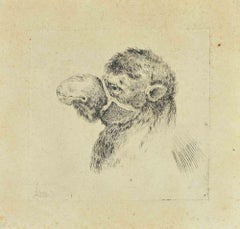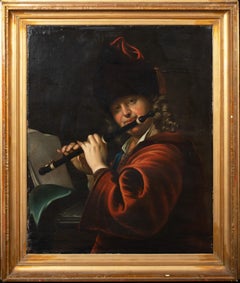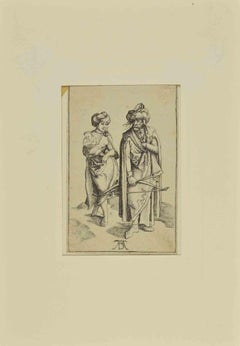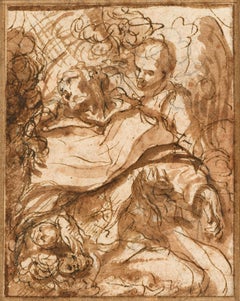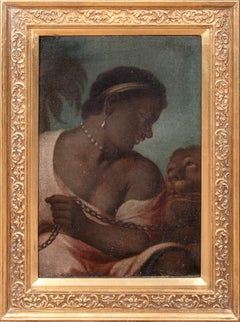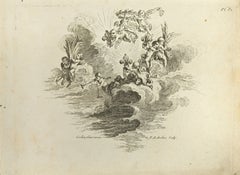18th Century and Earlier Art
to
4,009
4,130
1,490
653
515
726
Overall Width
to
Overall Height
to
7,526
20,755
155,828
236,873
1,876
2,278
4,816
6,385
5,903
13,135
20,098
24,810
17,373
13,278
5,319
3,077
1,242
49
21
16
12
4
2
1
1
1
1
3,664
3,168
388
4,721
2,367
1,545
1,482
1,360
866
690
656
504
432
424
401
328
289
211
192
186
180
178
168
3,587
2,316
1,927
1,106
915
160
127
91
82
79
2,307
3,421
4,955
1,373
Period: 18th Century and Earlier
Head of Camel - Etching by Stefano Della Bella - 17th Century
Located in Roma, IT
The Archangel Raphael Leaving Tobias' Family is an etching by Rembrandt Camel head is an etching by Stefano Della Bella executed in 17th century.
Monogrammed “SDB fec.”
Plate 8,1x8,5...
Category
Old Masters 18th Century and Earlier Art
Materials
Etching
PORTRAIT OF COURT MUSICIAN JOSEF LEMBERGER (1667-1740) Hungarian School
Located in Blackwater, GB
PORTRAIT OF COURT MUSICIAN JOSEF LEMBERGER (1667-1740)
Hungarian School
Large 18th Century Hungarian Portrait of court musician Josef Lemberger, oil on canvas. Superb quality and early important...
Category
18th Century and Earlier Art
Materials
Canvas, Oil
$6,563 Sale Price
20% Off
The Oriental and his wife - Etching after Albrecht Durer - 18th century
Located in Roma, IT
This etching is a reverse copy after Dürer's original (ca. 1495-1496), executed in 18th century.
Dürer's monogram at the bottom centre.
Provenance: Aglietti Gallery, 1969
Passepar...
Category
Old Masters 18th Century and Earlier Art
Materials
Etching
Saint Francis of Assisi in Ecstasy
Located in Paris, Île-de-France
Salvatore Rosa
(Naples 1615 - 1673 Rome)
Saint Francis of Assisi in Ecstasy
Pen and brown ink, brown wash over black chalk, on paper
7 x 5 cm
Bears the stamps of collections on the...
Category
Old Masters 18th Century and Earlier Art
Materials
Ink
The Royal Barge of George III, Westminster Bridge From Southbank, 18th Century
Located in Blackwater, GB
Roman Goddess "Dea Africa" Goddess Of The African Continent, 18th Century
Italian School
Large 18th Century Italian School portrait of the Roman Goddess "Dea Africa" holding a shac...
Category
18th Century and Earlier Art
Materials
Canvas, Oil
$3,336 Sale Price
20% Off
Angels - Etching by Nicholas Cochin - 1755
Located in Roma, IT
Angels is an etching realized by Nicholas Cochin in 1755.
Good conditions with slight foxing and aged margins.
Signed in the plate.
The etching was ...
Category
Modern 18th Century and Earlier Art
Materials
Etching
$252 Sale Price
25% Off
Mythological Scene - Oil on Board - 18th Century
Located in Roma, IT
Mythological Scene is a mixed colored painting on board realized by Anonymous artist in the XVIII century.
The artwork represents a mythological scene with women and cherubs.
Inclu...
Category
18th Century and Earlier Art
Materials
Oil, Board
$1,258 Sale Price
25% Off
Two Hand Coloured 18th Century Engravings from "Small Riding School" No 26 & 32
Located in Cotignac, FR
Two Mid 18th century hand coloured copper plate engravings of equestrian subjects by Johann Elias Ridinger. Initial signed 'in the plate' bottom right. Presented in fine gilt wood fr...
Category
Rococo 18th Century and Earlier Art
Materials
Watercolor, Ink
18th century pastel portrait of Lady Augusta Corbett and her son, Stuart
Located in London, GB
Collections:
Commissioned by Andrew Corbett, husband of the sitter;
The Venerable Stuart Corbett;
Sir Stuart Corbett;
By descent to 2002;
Sotheby’s, London 21 March 2002, lot.104;
Lowell Libson...
Category
Old Masters 18th Century and Earlier Art
Materials
Pastel, Gouache
18th Century French Oil Painting Tavern Scene Interior Merry Making Figures
Located in Cirencester, Gloucestershire
Merry Makers in the Tavern
French School, 18th century
oil on canvas
canvas: 8 x 11 inches
provenance: private collection, France
condition: good and sound condition
Category
Old Masters 18th Century and Earlier Art
Materials
Oil, Canvas
17th Century Diana and Actaeon Hernest Daret Mythological Oil on Canvas Green
Located in Sanremo, IT
Painting oil on canvas measuring 80 x 62 cm without frame and 105 x 82 cm with a contemporary frame by the painter Ernest daret, depicting the myth of Diana and Actaeon.
According t...
Category
Italian School 18th Century and Earlier Art
Materials
Canvas, Oil
Cocoa plant, caterpillar, ..., Plate 26, Metamorphosis Insectorum Surinamensium
Located in Middletown, NY
Metamorphosis Insectorum Surinamensium, Plate No. 26; Cocoa plant, caterpillar, pupa, and butterflies. The Netherlands: 1705. En...
Category
Naturalistic 18th Century and Earlier Art
Materials
Watercolor, Engraving
A Coachman - 18th Century British Figure watercolour drawing by Paul Sandby
By Paul Sandby
Located in London, GB
PAUL SANDBY
(1731-1809)
Study of a Coachman
Pencil and brown wash, shaped
Framed
16.5 by 9 cm., 6 ½ by 3 ½ in.
(frame size 32 by 22.5 cm., 12 ½ by 9 in.)
Provenance:
Iolo Williams;
Private collection.
Exhibited:
Sudbury, Gainsborough House, 1979.
Sandby was born in Nottingham and moved to London in 1745. He and his brother Thomas first worked in the military drawing department at the Tower of London, later working on a military survey of new roads and bridges in the Highlands. On leaving this post in 1751 he spent some time living with his brother who had been appointed Deputy Ranger of Windsor Great Park. There he assisted his brother, and made a series of drawings of the castle, town and neighbourhood. In 1760 he settled in London where he contributed to the first exhibition of the Society of Artists where he regularly exhibited until the foundation of the Royal Academy in 1768, becoming one of its founder members. In same year he was appointed chief drawing...
Category
Realist 18th Century and Earlier Art
Materials
Watercolor
Polychrome Virgin of the Annunciation - Catalonia
Located in PARIS, FR
Large catalan Virgin of the Annunciation in polychrome wood. Our Virgin is represented in the phase of the Conturbatio, Mary expresses her amazement a...
Category
Gothic 18th Century and Earlier Art
Materials
Wood
The Royal Square : A Glimpse of Old Paris - Original etching, Signed
Located in Paris, IDF
Jacques Rigaud (c. 1671/91-1754)
The Royal Square : A Glimpse of Old Paris
Original etching
Signed in the plate
On Arches vellum 38 x 56.5 cm (14.9 x 22.2 inch)
INFORMATION : Publi...
Category
Other Art Style 18th Century and Earlier Art
Materials
Etching
The Royal Militia District - Etching by Giuseppe Vasi - 1753
Located in Roma, IT
The architect is Paolo Posi, and the image is engraved by Giuseppe Vasi. Etching on paper.
Good condition.
The title: Celebratasi colla Machina della precedente sera la beneficenz...
Category
Modern 18th Century and Earlier Art
Materials
Etching
$540 Sale Price
25% Off
Simon-Mathurin Lantara (Circle of), Seaside Landscape
Located in Paris, FR
18th century French school in the manner of Simon-Mathurin Lantara. Seaside landscape with a vaporous and fine tone and a great lightness of touch. O...
Category
18th Century and Earlier Art
Materials
Canvas, Oil
Atraphaxis (Shrub); Cabomba (Carolina Fanwort) /// Botanical Botany Plants Art
Located in Saint Augustine, FL
Artist: Georges-Louis Leclerc, Comte de Buffon (French, 1707-1788)
Title: "Atraphaxis (Shrub); Cabomba (Carolina Fanwort)" (Hexandrie, Digynie, Plate 265)
Portfolio: Histoire Naturel...
Category
Naturalistic 18th Century and Earlier Art
Materials
Watercolor, Engraving, Laid Paper, Intaglio
Pair of Exceptional Italian Still Life Paintings of Flowers 18th century
Located in Rome, IT
- ANNA CATERINA GILLI or
GILLI Anna Caterina Turin 1729- 1751
Her paintings recorded in Turin as a decorative artist for the Royal Palace and the Stupinigi,
working in a simil...
Category
Baroque 18th Century and Earlier Art
Materials
Oil
17th Century by Giulio Benso The Expulsion of the Merchants From the Temple
Located in Milano, Lombardia
Giulio Benso (Genoa, Italy, 1592 - 1668)
Title: The Expulsion of the Merchants From the Temple
Medium: Oil on canvas
Dimensions: without frame 121 x 170 cm - with frame 144 x 193 cm
...
Category
Old Masters 18th Century and Earlier Art
Materials
Oil, Canvas
A Japanese Temple – English School, 18th century
Located in Middletown, NY
18th century image of a priest presiding over a traditional Japanese nuptual ceremony.
One plate from A new and complete collection of voyages and travels containing all that have b...
Category
English School 18th Century and Earlier Art
Materials
Watercolor, Handmade Paper, Engraving
unknown
Located in Los Angeles, CA
A classic terra cotta sculpture of Mercury signed Jean-Baptiste Pigalle (1714-1785).
Category
18th Century and Earlier Art
Materials
Terracotta
18th Century Lanscape Oil Painting of Matlock High-Torr
Located in London, GB
Thomas Smith of Derby
Matlock High-Torr Landscape
Oil on canvas
27 x 34.5 inches unframed
34 x 41.5 inches including frame
Thomas Smith of Derby (died 12 September 1767) was an Engl...
Category
Old Masters 18th Century and Earlier Art
Materials
Oil
The Theatre
Located in Douglas, Isle of Man
John Baptista Verbruggen was an English actor and painter born of Dutch descent. His date of birth is unknown but his death was recorded in 1708. His historical biography is confusin...
Category
18th Century and Earlier Art
Materials
Oil, Panel
The Birth Of Venus - Etching by Nicola Vanni - 18th Century
Located in Roma, IT
The Birth Of Venus from "Antiquities of Herculaneum" is an etching on paper realized by Nicola Vanni in the 18th Century.
Signed on the plate.
Good conditions and aged.
The etchin...
Category
Old Masters 18th Century and Earlier Art
Materials
Etching
A Pair of Forest Landscapes, Philipp H. Brinckmann, 1709 – 1761, Old Master
Located in Knokke, BE
A Pair of Forest Landscapes with River and Boat in the Foreground
Brinckmann Philipp Hieronymus
Spire 1709 – 1761 Manheim
Old Master
Signature: Signed "Ph. Brinckm" bottom lower lef...
Category
Old Masters 18th Century and Earlier Art
Materials
Copper
Baroque silver Vase with Flowers with a Fruit Tray and a Clock by A. Zuccati
Located in PARIS, FR
This unpublished composition is a recent addition to Adeodato Zuccati’s catalog. The study of this painting by Gianluca Bocchi, an Italian art historian specializing in Italian still lives, is available upon request.
This composition is typical of the productions of Adeodato Zuccati, an Emilian painter...
Category
Old Masters 18th Century and Earlier Art
Materials
Canvas, Oil
18th Century Venetian School Portrait of a Bishop Oil on Panel Green Brown Black
Located in Sanremo, IT
Painting oil on panel measuring 40 x 30 cm without frame and 48 x 38 with frame representing a great bishop of the Venetian school from the first half of the 18th century.
Very curi...
Category
Italian School 18th Century and Earlier Art
Materials
Oil, Wood Panel
$1,150 Sale Price
20% Off
Antique Map - Mare Pacificum - Etching by Johannes Janssonius - 1650s
Located in Roma, IT
Mare Pacificum is an antique map realized in 1650 by Johannes Janssonius (1588-1664).
The Map is Hand-colored etching, with coeval watercolorang.
Good conditions with slight foxing...
Category
Modern 18th Century and Earlier Art
Materials
Etching
Portrait of Cosimo III de’ Medici, Grand Duke of Tuscany, in Armour
Located in Firenze, IT
Portrait of Cosimo III de’ Medici, Grand Duke of Tuscany, in Armour
Oil on canvas, dating from the late 17th to the early 18th century.
Original period frame in carved and gilded wo...
Category
Baroque 18th Century and Earlier Art
Materials
Canvas, Oil
17th Century French sanguine drawing of maiden's harvesting flowers
By (Circle of) Nicolas Poussin
Located in Petworth, West Sussex
Circle of Nicolas Poussin (French, 1594-1665)
Maiden’s harvesting flowers
Sanguine on paper
8. ¾ in. (22 cm.) tondo
Category
Old Masters 18th Century and Earlier Art
Materials
Paper
Set of Three Color Engravings from "Herbier de la France" by Pierre Bulliard
Located in Saint Augustine, FL
Artist: Pierre Bulliard (French, 1742-1793)
Title: "Le Pied de Griffon (Griffin's Foot)", "La Laureole (The Laurel)", and "Le Cabaret d'Europe (The European Cabaret)"
Portfolio: Herb...
Category
Old Masters 18th Century and Earlier Art
Materials
Laid Paper, Engraving, Intaglio
18th century English portrait of a lady beside an urn, with a basket of flowers
By Tilly Kettle
Located in Bath, Somerset
Portrait of a lady wearing a white gown with a red cloak, pearls in her hair and draped over one shoullder, standing beside a classical urn with a basket of flowers, c.1765.
The portrait is believed to be a companion portrait of a John (1741-1816) or James (1751-1807) Durno which is housed in an identical frame. The sitter is possibly either the wife of John who was Janes Byres of Stonywood or John and James's sister Elizabeth. (James never married). The Durno family were based around the Aberdeen area of Scotland and John was an advocate in the area and then later a customs official in Jamaica. James was a successful timber merchant, spending time in the Baltic before being made His Majesty's Consul in Memel, Prussia.
The portrait is likely to have been painted before Tilly travelled to India in 1768, when John, Jane and Elizabeth would have been in their twenties.
We are gtrateful to Mark Beattie for sharing his family knowlege and research on the portrait.
Provenance:
With W. C. Beattie in the mid 19th century, and by descent through the family
Private collection, Kent
With thanks to Hugh Belsey who has confirmed this to be the work of Tilly Kettle from photographs.
Tilly Kettle (1735-1786) was born in London, the third of six children by Henry Kettle (c.1704-c.1773), a coach painter, and his wife Ann. He attended William Shipley...
Category
Old Masters 18th Century and Earlier Art
Materials
Canvas, Oil
Portrait of a Young Man - 17th Century Portrait in Oil
By Pieter Harmensz Verelst
Located in London, GB
Circle of Pieter Harmensz Verelst
1618 - 1678
Portrait of a Young Man
Oil on oak panel
Image size: 7 ½ x 5 ¾ inches
Dutch ripple frame
Category
Old Masters 18th Century and Earlier Art
Materials
Oil, Panel
San Francisco Javier
Located in Miami, FL
Colonial School, Mexico, XVIII Century
"San Francisco Javier"
Oil on canvas
18 x 14 in.
Category
Old Masters 18th Century and Earlier Art
Materials
Canvas, Oil
$8,000
Archipelagus Septentrionalis - Etching by Johannes Janssonius - 1650s
Located in Roma, IT
Archipelagus Septentrionalis is an ancient map realized in 1650 by Johannes Janssonius (1588-1664).
Good conditions.
From Atlantis majoris quinta pars, Orbem maritimum [Novus Atlas...
Category
Modern 18th Century and Earlier Art
Materials
Etching
$1,620 Sale Price
25% Off
Dutch or Flemish Landscape with Figures & Animals
Located in Milford, NH
A beautifully detailed late 17th or early 18th century Dutch or Flemish landscape with cows grazing in the water, goats, dogs, and other animals near the water’s edge, under the watchful eye of the herdsmen, on a backdrop of rolling hills and trees. Oil on wood panel, unsigned, and housed in a Rudolph...
Category
Flemish School 18th Century and Earlier Art
Materials
Oil, Wood Panel
Portrait of a Privateer
Located in London, GB
Portrait of a Privateer
Francis Hayman
1708 - 1776
Oil on canvas
Image size: 20 x 14 inches (51 x 36 cm)
Contemporary style frame
Provenance
Charles Fleischmann Esq
Here, a small ...
Category
English School 18th Century and Earlier Art
Materials
Canvas, Oil
Vierge en majesté mosane. Sedes Sapientiae.
Located in PARIS, FR
Grande Vierge à l'Enfant en chêne de la fin du 13ème siècle ou début du 14ème siècle. La plastique des visages et du Christ évoque le 13ème siècle (le visage de la Vierge évoque le visage de la Sedes Sapientiae...
Category
Gothic 18th Century and Earlier Art
Materials
Wood
$15,306 Sale Price
25% Off
The Flight of the Holy Family to Egypt, Oil on canvas, Italian school circa 1680
Located in Paris, FR
The Flight into Egypt, an episode of childhood of Christ in the New Testament, representing Joseph, Mary and Jesus on a donkey, fleeing from Palestine to Egypt, at the behest of the ...
Category
Old Masters 18th Century and Earlier Art
Materials
Canvas
$10,564 Sale Price
20% Off
Circle of David Teniers, Landscape with Peasants by an Inn and a River, Dutch
By David Teniers the Younger
Located in Greven, DE
Circle of Teniers, Peasants in a Landscape passing by a river and an Inn.
Category
Baroque 18th Century and Earlier Art
Materials
Oil, Panel
$3,594 Sale Price
25% Off
"Meeting in the Woods" 19th Century Antique Oil Painting on Canvas
By George Henry
Located in Jacksonville, FL
The painting is signed.
Description:
George Henry Boughton: A Master of Narrative and Natural Beauty
George Henry Boughton, a distinguished Anglo-American artist of the 19th centur...
Category
Academic 18th Century and Earlier Art
Materials
Oil, Canvas
View of an Antique City, a wash landscape by Jan de Bisschop (1628 - 1671)
Located in PARIS, FR
The attribution to Jan de Bisschop has been confirmed by the RKD with the following comment: "We base this attribution on the dark washes, the subject represented and the monogram".
...
Category
Old Masters 18th Century and Earlier Art
Materials
Pen, Ink
Three studies executed in the Pitti Palace in 1761 by Jean-Honoré Fragonard
Located in PARIS, FR
This brilliant study sheet, of which we present here a counterproof, is a souvenir of Fragonard's return journey from Italy. Between April and September 1761, he accompanied the abbot of Saint-Non on his way back to France. Three studies after the masters taken from the Pitti Palace’s gallery in Florence are gathered on this sheet. Although The Ecstasy of Saint Margaret...
Category
Old Masters 18th Century and Earlier Art
Materials
Carbon Pencil
'Portrait of James Caulfield' by William Hogarth, Etching
Located in Oklahoma City, OK
This 21" x 18" etching was produced by William Hogarth in the mid-18th century. The work has been newly matted and framed with archival materials. The subject, identified as James Caulfield, 4th Viscount, 1st Earl of Charlemont (1728-1799), became commander in chief of the Irish Volunteers...
Category
Realist 18th Century and Earlier Art
Materials
Etching
Axiom - Etching by Francesco Mazzoni - 18th Century
Located in Roma, IT
Axiom is an original etching on paper realized by Francesco Mazzoni in the 18th century.
Signed on the plate. Included a Passepartout: 45 x 30.5 cm
Francesco Mazzoni ( 1738-1989).
...
Category
Old Masters 18th Century and Earlier Art
Materials
Etching
$341 Sale Price
25% Off
Colonel Mellish's Spaniels, Mother & Puppies, 18th Century
By Henry Bernard Chalon
Located in Blackwater, GB
Colonel Mellish's Spaniels, Mother & Puppies, 18th Century
attributed to HENRY BERNARD CHALON (1770-1849)
Large 18th Century portrait of Colonel Mellish's hunting spaniels, mother ...
Category
18th Century and Earlier Art
Materials
Oil, Panel
$3,781 Sale Price
20% Off
“At The Oasis" 19th Century Antique Landscape orientalist Oil Painting on Canvas
Located in Jacksonville, FL
Provenance:
Private Collection, Naples Fl, to Andrew Ford Collection, Sarasota, Fl. 2018
Description:
Georges Washington was born out of wedlock and held a...
Category
Realist 18th Century and Earlier Art
Materials
Oil, Canvas
Le Belier - Etching by Jean Charles Baquoy - 1771
Located in Roma, IT
Le Belier is an etching realized by Jean Charles Baquoy in 1771.
It belongs to the suite "Histoire Naturelle de Buffon".
The Artist's signature is engraved lower right.
Good condi...
Category
Modern 18th Century and Earlier Art
Materials
Etching
$251 Sale Price
25% Off
17th Century By Giuseppe Caletti The Court Jester From Dosso Dossi Oil on Canvas
Located in Milano, Lombardia
Beautiful original frame in carved and gilded wood.
Oral expertise by Prof. Enrico Maria Dal Pozzolo.
Category
Old Masters 18th Century and Earlier Art
Materials
Canvas, Oil
1700's Venetian Old Master Ink Drawing St. Marks Lion Angelic Figures Flowers
Located in Cirencester, Gloucestershire
The Lion of St. Mark
Venetian Old Master, mid 18th century
circle of Giovanni Battista Tiepolo (Venetian, 1696-1770)
ink and watercolour drawing on paper mounted on a card frame, unf...
Category
Rococo 18th Century and Earlier Art
Materials
Watercolor, Ink
$1,260 Sale Price
30% Off
Virgen del Carmen
Located in Miami, FL
Colonial School, Mexico, XVIII Century
"Virgen del Carmen"
Oil on canvas
70 x 40 in
Category
Old Masters 18th Century and Earlier Art
Materials
Canvas, Oil
$8,000
17th Century Still Life Niccolò Stanchi Flowers Oil on Canvas Red Pink White
Located in Sanremo, IT
Painting oil on canvas measuring 67 x 45 cm without frame and 82 x 60 depicting a vase of flowers by the painter Niccolò Stanchi ( Rome 1626 - 1690 ).
The Stanchi brothers (Giovanni...
Category
Italian School 18th Century and Earlier Art
Materials
Canvas, Oil
$16,230 Sale Price
20% Off
Allegory of Autumn With Bacchante - Etching by Filippo Morghen - 18th Century
Located in Roma, IT
Allegory of Autumn With Bacchante from "Antiquities of Herculaneum" is an etching on paper realized by Filippo Morghen in the 18th Century.
Signed on the plate.
Good conditions and...
Category
Old Masters 18th Century and Earlier Art
Materials
Etching
Honden Jagen Op Een Beer (Hounds Hunting a Bear) /// Old Masters Dogs Landscape
By Abraham Hondius
Located in Saint Augustine, FL
Artist: Abraham Hondius (Dutch, c.1625-1691)
Title: "Honden Jagen Op Een Beer (Hounds Hunting a Bear)"
*Signed and dated by Hondius in the plate (print...
Category
Old Masters 18th Century and Earlier Art
Materials
Etching, Laid Paper, Intaglio
King's College, Cambridge engraving Pieter van der Aa after David Loggan iii
Located in London, GB
Pieter van der Aa (1659 - 1733), after David Loggan (1634 - 1692)
King's College, Cambridge
Engraving
12 x 16 cm
An eighteenth-century view King's College, Cambridge, engraved by Pi...
Category
Realist 18th Century and Earlier Art
Materials
Engraving
18th Century by Giuseppe Bonito The Painter's Studio or Allegory of Painting
Located in Milano, Lombardia
Giuseppe Bonito (Castellammare di Stabia, Italy, 1707 - Naples, Italy, 1789)
Title: The Painter's Studio or Allegory of Painting
Medium: Oil on canvas
...
Category
Old Masters 18th Century and Earlier Art
Materials
Oil, Canvas
Remarkable Pair of 16th C. Italian Oil Paintings
Located in Los Angeles, CA
Two, large, stunningly painted, left and right, oil-on canvas, Italian paintings of the Emperor's Vespasian and Julius Caesar, with their names inscribed on the lower left hand corne...
Category
18th Century and Earlier Art
Materials
Canvas, Oil
"Four Women in National Costumes, " Etchings by Wenceslaus Hollar
Located in Milwaukee, WI
"Four Women in National Costumes" is a set of four original etchings by Wenceslaus Von Prachna Hollar.
3 5/8" x 2 3/8" each print
19 1/8" x 18 1/2" frame
Wenceslaus Von Prachna Ho...
Category
Old Masters 18th Century and Earlier Art
Materials
Etching
17Th Century Animals Scene Angelo Maria Crivelli Fight Fox Oil on Canvas Orange
By Angelo Maria Crivelli
Located in Sanremo, IT
This fox in the chicken coop, oil on canvas, 105 x 156 without frame and 135 x 185 cm with frame, was clearly painted by Angelo Maria Crivelli (Milan 1660 - 1730) called Crivellone; painter from the Milanese stable but also very active in Piedmont thanks to the Savoy family.
The theme in question was very successful in his time and he also developed it vertically, as we can see in some of his works at Castello Sforzesco; here the defense of the hen house...
Category
Italian School 18th Century and Earlier Art
Materials
Canvas, Oil
Recently Viewed
View AllMore Ways To Browse
18th Century Dutch Oil Paintings
19th Century Oil Painting Pastoral Scene
1965 Watch
Wrestler Sculpture
15th Century Italian Painting
Wrestling Vintage
1962 Watch
18th Century Oil Painting Woman
1965 Vintage Watch
1984 Clothing
19th Century Painting Lovers
Woman Posing Seated
1974 Vintage Watch
1930s Actress
1953 Watch
Wood Carving Portrait
18th Century Venetian Paintings
1980 Japanese Poster
